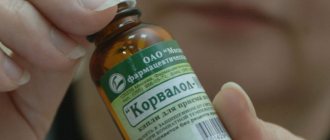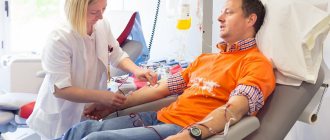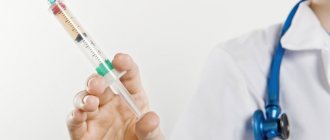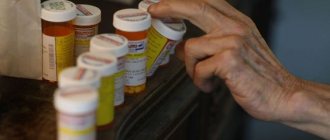“Online registration for vaccination against Covid-19 infection”
Angina pectoris is a serious disease that should not be ignored. Properly provided emergency care for angina pectoris will help prevent the development of a heart attack.
Angina pectoris is a consequence of coronary heart disease. The reason for its development is coronary insufficiency, which occurs due to narrowing of the arterial lumen.
What are the causes of an angina attack?
To help the victim, you need to know how an angina attack manifests itself, as well as the reasons for its development. It usually develops during physical activity. Often the trigger is stressful situations. In this case, they talk about exertional angina.
There is another variant of an angina attack; it can occur even at rest. This usually happens during sleep or in the morning. This type of disease is called resting angina. The unpredictable development of an attack is the most dangerous.
The following factors can also provoke angina:
- increased blood pressure;
- consumption of energy drinks and alcohol;
- smoking;
- listening to loud music.
The frequency of attacks is influenced by the degree of reduction in the lumen of the coronary artery. With pronounced pathology, pain appears up to several times a day. With age, the number of ailments increases. If angina is diagnosed, emergency care is necessary.
Angina attacks can occur at different intervals. The most severe of them lead to necrosis in the heart muscle, namely myocardial infarction. Subsequently, a scar will remain in this place.
The disease is accompanied by pressing pain accompanied by burning sensations. The pain syndrome is localized in the sternum area. The pain is reflected in the neck, in the arm, and even moves to the jaw.
The attack is characterized by the following symptoms:
- pale skin;
- increased blood pressure;
- heart rhythm failure;
- dyspnea;
- nausea;
- perspiration;
- headache.
The duration of the illness on average is no more than five minutes, but there are longer options when the illness causes concern for more than 10 minutes. The attack may be short-lived and go away on its own.
Prolonged attacks of angina are the most dangerous; they are the cause of the development of cardiac complications, such as, for example, myocardial infarction. In order to avoid complications, it is important to provide the victim with adequate emergency care.
Emergency care for angina pectoris
Angina attacks require emergency care. The algorithm of actions for eliminating the symptoms of the disease includes the following procedures.
If the illness was provoked by physical activity, the patient must immediately stop moving, take a comfortable position, any exertion is prohibited, and he must not get up or walk. It is important to monitor your breathing; it should be even and deep.
In addition, the patient needs fresh air. You need to remove tight clothes from him and create a suitable temperature regime. First aid for angina pectoris includes taking medications, which should always be on hand for people suffering from heart disease.
To relieve an attack, the patient is given the following medications:
- Lay the sick person down with his head raised.
- Unfasten the belt, collar, loosen the tie, which will help relieve suffocation.
- Provide air access to the room.
- Chew an aspirin tablet 250-300 mg, take a nitroglycerin tablet 0.5 mg or as a spray under the tongue (if there is no effect, repeat twice after 5-7 minutes, under control of blood pressure and heart rate).
- If severe weakness appears, raise your legs to a level above your head, give them water to drink and no longer give nitroglycerin.
- Do not leave the patient until the doctor arrives.
- The doctor must show all medications taken.
- Call “103” immediately if the attack is not stopped.
An attack of angina can cause panic and anxiety. Close people urgently need to reassure the patient. You may need to take a sedative. These actions will help eliminate the ailment. After the attack has stopped, the patient should remain in bed. To prevent relapses, it is important to dose physical activity and avoid psycho-emotional stress.
Features of taking Nitroglycerin during an attack of angina
Nitroglycerin is the most effective remedy for relieving an attack of angina. But it should be taken with caution.
The action of Nitroglycerin should begin within a couple of minutes; if this does not happen, the dose can be repeated. But you should know that you should not take more than three tablets at a time.
Nitroglycerin is not always indicated for use. In some cases you cannot drink it. Contraindication is low blood pressure - hypotension.
Hypotension is accompanied by the following symptoms:
- general weakness;
- dizziness;
- paleness of the skin;
- cold sweat appears.
Taking Nitroglycerin for hypotension will worsen the patient's condition and reduce blood supply to the myocardium. It is advisable to measure your blood pressure before taking the medicine, if possible. In addition, this drug causes severe headaches. To relieve these effects, you will need to take painkillers.
Not every angina attack requires calling an ambulance. You will need to call a doctor in cases where:
- an attack of angina occurred for the first time;
- the discomfort did not go away after five to ten minutes;
- if the illness has become severe, symptoms appear that were not there before;
- it was not possible to eliminate the symptoms of the disease in the usual way;
- An unbearable growing pain appeared in my heart.
For angina pectoris, first aid plays a very important role.
Prevention
An active lifestyle is the main recipe for preventing all diseases. In addition to exercise, proper nutrition (more raw fruits and vegetables, low salt and carbohydrate intake), and quitting smoking and alcoholic beverages are necessary. After 40 years, regular monitoring of blood pressure, blood sugar and cholesterol levels is required. It is important to be in a positive mood in life and avoid stressful situations.
A primary attack of angina is an alarming sign that can signal possible heart disease. The patient needs to consult a cardiologist.
Cardiologist Sushko O.F.
What is angina and why does it occur?
To help a patient with an attack of angina, you should know what this condition is and what are the reasons for its development. Angina pectoris is a clinical syndrome accompanied by sudden and acute pain in the sternum due to impaired blood circulation in the coronary artery. Previously, this symptom was called “angina pectoris,” but now this concept is outdated.
The main cause of the pathology is a disruption of blood flow through the vessels due to the formation of atherosclerotic plaques on their walls. The following provoking factors lead to this:
- bad habits (smoking, alcohol, drugs);
- hypertonic disease;
- increased blood cholesterol levels;
- poor nutrition;
- sedentary work, lack of physical activity;
- excess body weight;
- diabetes;
- anatomical aging of the body;
- frequent stress;
- metabolic disorder.
Together with hormonal disorders, changes in blood composition and many other reasons, these factors provoke the development of diseases of the heart and blood vessels, the symptom of which is angina pectoris.
Help with myocardial infarction
Competent first aid for the development of myocardial infarction is the key to its successful treatment and prevention of many dangerous consequences. A heart attack is a severe condition accompanied by necrosis of individual areas of the myocardium. Emergency diagnosis of such a condition in a patient includes an assessment of his well-being and the presence of certain symptoms. Laboratory blood testing is valuable, which allows us to identify the presence of markers formed in the blood during the development of a heart attack. Among the clinical manifestations, the following signs indicate a heart attack:
- pain syndrome localized behind the sternum, spreading to the area of the arm, shoulder blade, neck and jaw;
- the duration of the attack is more than 2 hours, which makes it possible to differentiate this condition from angina pectoris;
- the appearance of nausea, vomiting, fainting;
- lack of effect after repeated administration of Nitroglycerin;
- development of cardiogenic shock, coma.
An ECG helps confirm or refute a heart attack. Necrosis is characterized by such changes on the electrocardiogram as displacement of the ST segment (it exceeds the isoline), as well as deformation of the Q wave.
Each of the subsequent actions during treatment is carried out in the absence of a therapeutic effect from the previous one. The algorithm for providing assistance in case of a heart attack is as follows:
- solution of Omnopon, Droperidol or Diphenhydramine through a dropper for 5 minutes in combination with saline solution. In parallel, acetylsalicylic acid orally;
- Fentanyl is used to lower blood pressure. The dosage is selected individually, depending on blood pressure;
- therapy aimed at dissolving blood clots and preventing their formation using beta-blockers;
- Nitroglycerin solution (1 ml per 100 ml of physiological solution). The medicine is administered with constant monitoring of blood pressure at a rate of 25 mcg/min. If the dose is well tolerated, the doctor increases the drip rate by 10 mcg every minute.
Treatment of myocardial infarction is carried out in an inpatient setting
When respiratory function is depressed, oxygen therapy is used. Inhalation using nitrous oxide and pure oxygen. Throughout the entire period, respiration, blood pressure, pulse and other vital signs are monitored. If necessary, analgesic drugs are reintroduced.
Important! The most favorable prognosis for the patient is possible if medical care was provided within the first 72 hours after the development of myocardial infarction.
Care for varicose veins of the lower extremities
Varicose veins of the lower extremities - enlargement of the superficial veins of the legs - are associated with weakness of the vein walls and a number of predisposing factors. The disease is characterized by the appearance of protrusions and nodular swellings on the lower extremities along the saphenous veins.
Main symptoms of the disease:
- leg pain;
- a feeling of warmth and burning in the legs along the veins;
- heaviness in the legs;
- itching;
- night cramps in the legs;
- swelling in the evening;
- dilated veins;
- darkening and thickening of the skin of the legs;
- trophic ulcers.
Risk factors:
- genetic predisposition;
- floor;
- hormonal influences (pregnancy);
- weight gain;
- lifestyle (hard physical work, prolonged standing, high ambient temperature).
Treatment principles:
- recommendations regarding lifestyle and body position;
- wearing elastic bandages, tights or stockings;
- use of venotonic drugs;
- sclerotherapy;
- surgical treatment (removal of affected veins).
Care Tips:
- keep your legs elevated during sleep and rest;
- change the position of your legs more often or periodically walk at a fast pace if you have to sit or stand for a long time;
- rinse your feet with cool water after a warm bath or shower;
- It is not recommended to take hot baths;
- prolonged exposure to the sun should be avoided;
- You need to wear shoes with medium-height heels (3 - 4 cm);
- It is not recommended to wear tight clothes and tight belts, stockings and socks with tight elastic bands;
- exercise regularly;
- walking and swimming;
- Sports not recommended: tennis, weightlifting, high jumping;
- a balanced diet with a reduced number of calories compared to the norm; in case of excess weight, the load on the veins increases;
- the use of elastic stockings or elastic bandages with varying degrees of compression;
- venotonic drugs.
How to recognize an attack?
Assistance for angina pectoris should be provided immediately in the presence of threatening symptoms.
Cardialgia. This term refers to a painful sensation that appears in the left region of the sternum. In most cases, discomfort spreads to other parts of the body - shoulder blades, limbs, neck and forearm. Cardiac arrhythmia is often observed with cardialgia. The most unpleasant and intense pain is felt in the middle of the sternum on the inside, where the spongy tissue is located. It connects the rib cage with the ribs and the spinal column.
Pain in the left sternum.
- Hypertensive crisis - symptoms. Emergency first aid for hypertensive crisis - algorithm of actions
Types of pain by nature:
- burning;
- pressing;
- bursting.
By duration:
- stable (10-15 minutes);
- progressive (5-45 minutes);
- spontaneous (less than 5 minutes).
Problems arise when inhaling and exhaling.
Difficulty breathing. The victim may have trouble breathing in and out. This reaction is caused by myocytes - cells of cardiac tissue that are in dire need of oxygen.
Shortness of breath occurs during hypoxia, and inhalation is accompanied by pain. Help can be provided through medications.
Disturbance in cardiovascular work. There is a feeling of numbness in the limbs, the skin color becomes marbled or pale. Cyanosis or blue discoloration occurs if acute oxygen deficiency develops inside. Blood pressure increases, which increases the risk of stroke or heart attack. The feet and palms may be clammy and cold sweat is common. There are often cases when the victim complains of lightheadedness and headache.
There is a feeling of numbness in the limbs, the skin color becomes marbled or pale.
Atypical signs of pathology:
- panic attack, anxiety, fear of death;
- pain in teeth and throat;
- severe weakness without pain;
- nausea, burning in the stomach, belching.
First aid for angina pectoris, which is accompanied by a hypertensive crisis, must be provided before the arrival of medical workers. This condition is dangerous for the patient. Cardiopulmonary resuscitation is sometimes required.
In what cases is Nitroglycerin contraindicated during an attack of angina?
The patient or his relatives should be aware that if signs of low blood pressure are detected (with collaptoid angina), taking drugs from the group of organic nitrates (Nitroglycerin, Isoket, etc.) is contraindicated. The following signs may indicate hypotension:
- the patient experiences severe weakness;
- dizziness;
- pallor;
- cold sweat.
In such cases, the sequence of actions should be as follows:
- Lay the patient down.
- Call an ambulance.
- Give him a crushed Aspirin tablet.
- To reduce pain, you can use tablet analgesics (Baralgin, Sedalgin, etc.).









